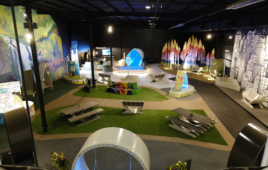The potential is great for increased geothermal energy to help reduce energy costs.

The first US geothermal power plants were built in 1962 at The Geysers dry steam field in northern California. It is still the largest producing geothermal field in the world.
Photo courtesy of the Geothermal Education Office, Tiburon, Calif.
In thousands of homes and buildings across the US, geothermal heat pumps use the relatively constant temperatures of underground water to heat and cool buildings cleanly and inexpensively. The most common way of capturing the energy from geothermal sources is to tap into naturally occurring “hydrothermal convection” systems where cooler water seeps into the Earth’s crust, heats, and then rises to the surface. When the heated water reaches the surface, it is a relatively simple matter to capture the steam it releases and use it to drive electric generators. In addition to scavenging the steam from natural orifices in rock, geothermal power plants drill their own holes to capture it more effectively.
Geothermal power plants typically use one of three possible processing methods, all of which pull hot water and steam from the ground, use it, and then return it as warm water to prolong the life of the heat source. In the simplest design, the steam goes directly through the turbine, then into a condenser where the steam transforms back into water. In a second approach, extremely hot water is depressurized or “flashed” into steam, which can then be used to drive the turbine.
In the third approach, called a binary system, the hot water passes through a heat exchanger, where it heats a second liquid, such as isobutene, in a closed loop. The isobutane boils at a lower temperature than water, so it is easier to convert into steam to run turbines.
The design choice is determined by the resource. If the water comes out of the well as steam, it can be used directly, as in the first design. If it is hot water of a high enough temperature, a flash system can be used. Otherwise, it must go through a heat exchanger. Since it’s been reported that more hot water than pure steam or high-temperature water sources are available, more growth potential is in the heat exchanger design.
One of the largest geothermal systems now in operation is a steam-driven plant in an area called “The Geysers,” north of San Francisco, Calif. The heat that is used for energy is all steam, not hot water. Although the area was known for its hot springs as far back as the mid-1800s, the first well for power production was drilled in 1924. Deeper wells were drilled in the 1950s, but real development didn’t occur until the 1970s and 1980s. By 1990, 26 power plants had been built, for a capacity of more than 2,000 MW.
Because of the rapid development of the area in the 1980s and the technology used, the steam resource has been declining since 1988. Today, The Geysers has a capacity of 850 MW, which still meets nearly 70% of the average electrical demand for California’s North Coast region. The plants at The Geysers use an evaporative water-cooling process to create a vacuum that pulls the steam through the turbine and produces power more efficiently. But this process loses 60% to 80% of the steam to the air and does not return it underground. While the steam pressure may be declining, the rocks underground are still hot. Some efforts are under way to remedy the situation, including the Santa Rosa Geysers Recharge Project, which involves injecting treated waste water from neighboring communities through a 40-mile pipeline. Recharging the existing reservoirs is estimated to increase output by 85 MW and provide enough electricity for approximately 85,000 homes.
Geothermal energy has the potential to play a significant role in moving the US (and other regions of the world) toward a cleaner, more sustainable energy system. It is one of the few renewable energy technologies that can supply a continuous, base-load power. The costs for electricity from geothermal facilities are also declining. Some geothermal facilities have cut the price of electricity in half since 1980. New facilities can produce electricity for between 4.5 and 7.3 cents/kw-hour, which makes it competitive with new conventional fossil fuel-fired power plants.
::Design World::
Filed Under: Green engineering • renewable energy • sustainability, Energy management + harvesting





Tell Us What You Think!